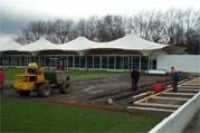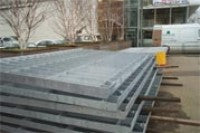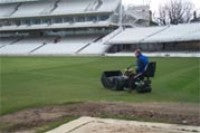Lords lead the way
Lords lead the way

I suppose that somebody has to be first and we have had to look at new systems for a while now that will enable the ground to be used for events other than cricket. Lords generally, is only filled approximately four times a year and it therefore makes economic sense to look at alternative use of the stadium.
The difficulty we face in opening the stadium to other events is the square in the middle. There is now a tried and tested system on the market albeit in Australia that will hopefully change the way we manage the grass maintenance at the MCC.
We are installing two complete wickets outside the stadium in our practice ground, grown in steel trays that can be lifted out and transported to the main square. Once transported to the square the wicket is gently eased into a specially prepared hole with concrete bearers ready for play.
These wickets are maintained out on the practice ground and if this trial is successful, it could lead to more portable wickets grown outside and only one wicket space needed in the centre of the stadium.
In essence, if the trial is successful then we have the ability to play other sport, hold functions and even pop concerts at the venue, in the knowledge that the square will not be damaged.
Apart from the opportunities that this system gives us as a multi use facility, there are other benefits. One of the biggest problems that we face is that while we host a four or five day match we obviously can't be on the square preparing another wicket for the next game. This inhibits the amount of cricket that can be played in a season. By having wickets, prepared in advance, outside of the stadium we now have the ability to play more regular fixtures.
We are currently in the process of excavating and preparing the area that the wickets will be housed. The system has been developed by

Each tray filled with loam is termed a male tray and is 25 metres long by 3 metres wide. In the ground there will be the female tray that the male tray sits in. This system helps to avoid ground movement and encroachment and retains the correct levels. The area designated for the portable wicket will be constructed in a similar fashion with a concrete base and female tray.

The areas on either side of the wickets will be made up with a gravel carpet and drainage system, a 100mm layer of sand with reflex mesh elements incorporated in it to take the weight of the transport vehicle that will move the portable wickets between this area and the square in the stadium.
The trays have special locking mechanisms that can be attached to the transport. Once attached the transport vehicle lifts out the tray using hydraulics. Due to the combined weight of the wicket and the transport vehicle, huge low flotation tyres are used to spread the weight.
The club are also deciding on the type of system to use to reinforce the outfield and to improve the current drainage problems. As I have mentioned before, the outfield is built on London Clay and there only has to be a cloud in the sky for the ground to puddle!
There are a number of options open to us and I will discuss these options nearer the time that a decision is made. I will also continue to update you on our findings as we develop these portable wickets.
Now back to normal business, the preparation of our existing grass.
So far this year has been wet and cold, so it has been difficult to get on and do very much yet. However the last few days have been dry, so
On the square I would like to have done some rolling last week, but the forecast had said that there would be some heavy showers about. As it transpired we missed these and in hindsight I could have 'banked' a few hours of rolling. We rely on accurate forecasting, but I suppose that they can't be right all the time.
We have 18 wickets on the square and I try to 'bank' about 80 hours of pre-season rolling. This will comprise of about 30 hours using our Allett 36" Cylinder mowers, 30 hours of rolling using our 30 cwt (1.5 tonnes) rollers and then about 20 hours using the same rollers but with water as ballast to take their weight up to about 2.5 tonnes.
All of these operations will include an equal amount each of travel in different directions. So we will roll stumps to stumps, both square diagonals and across the square as well.
We designate wickets early on for the various games that will be played, so now is the time to decide what remedial works need to be carried out. I felt that we had a good renovation of the square last autumn and the new grass establishment is coming along nicely. If we want to make up any slight levels or do a little seeding on particular wickets we should be able to establish the grass in time for play from next month onwards.

However the weather was good in September and we were able to carry out good renovations on the square and outfield.
The seed mix we used was treated with 'fortiva' so establishment was good, coupled with the fact that the weather was quite mild. There has even been growth on the square so far this year.
I have been using amino acids on the square to encourage growth, so far three applications have gone on at six week intervals. I have also managed to apply some seaweed extract, and a half rate application of 6:9:6 fertiliser.
So far there is not much to report on the disease front, which is encouraging.
Last season we introduced four newly laid wickets that all had one day games played on them. This year I have earmarked them for four day games because they have played with some consistency. All I look for is an even bounce on new wickets. Over time we can improve the pace and the bounce with rolling and care as they mature.
Over the next few weeks I will step up our maintenance schedule of feed, rolling and cutting as we move towards the season start.
Good luck to all of you, starting this process.
